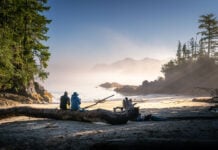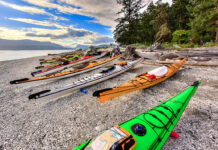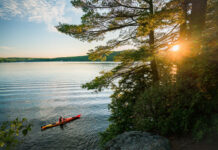Sitting on a beach on the Oregon Coast, I’m looking at a headland formed 15 million years ago by magma flowing down the ancestral Columbia River. The coastal Siltez would have sat on the same beach and looked at the same headland for millennia.
The rivers I run were carved by water over the course of eons. Looking at old grainy black and white photos from the early 1900s, I can tell exactly where those photographers stood. In a world seemingly transitory, nature is an anchor. Nature endures.
But, Nature’s permanence is an absolute myth
Mountains rise and fall. Rivers carve new channels. Usually, the change is just too slow for us to take notice. Not always of course—Crystal Rapid on the Grand Canyon was famously formed in a single day in 1966. In my closest aquatic playground—the Columbia River Gorge—I recognize specific basalt cliffs from Carleton Watkins’ 1867 images, but I also know the whole gorge was carved suddenly in a series of floods during the last ice age.
If I tilt my head to the north a few degrees, I can see Mt. St. Helens. When I woke up one morning in grade five, it was 9,677 feet tall. Then it blew its top and by evening it was more than 1,000 feet shorter.
Transience and permanence have been on my mind a lot lately.
Last summer a friend and paddling mentor passed away. He taught me to paddle whitewater, I taught him to paddle on the sea. He surfed river waves in an open canoe with an ease, earning himself the nickname, the Big Smooth.
For all his grace on the river, he was jittery far from shore in the uncertain slosh of swell. The first time I took him out in a force 3 wind, he literally kissed the ground when we landed.
Beyond paddling skill, Carl displayed traits I wish were as enduring as the basalt headlands of the Oregon coast—love of nature, kindness, thoughtfulness, humor, and virtue without needing credit.
After he died, a friend found a set of his old musings about rivers. Humor and love of nature flowed through his writing. So did the power of rivers to endure. His descriptions of runs on the Sandy River from the 1980s matched what he’d shown me decades later, even after a major dam was removed and the channel had shifted twice during floods.
Rivers move and mountains, like people, grow and fall.
On a hike long ago, a friend contended if we perceived time differently, we’d think of mountains and rivers as living beings. They are born and die, move and change.
They just do it slowly enough it doesn’t register in our mayfly lives. I’m not sure whether or not I buy it, or where exactly the boundary between living and nonliving things lies. I’ll leave this to biologists and philosophers. What I do know is water has another power, whether it’s alive or not: The ability to heal.
I’m not the only one to think so.
In Greek mythology, Thetis dipped her son Achilles, who was supposed to die young, in the River Styx for protection. Baptisms do the same. Ishmael, embarking on the Pequod, went to sea whenever he felt “a damp, drizzly November in his soul.”
As I write these words, autumn rains bringing the whitewater season have appeared in the forecast. It will be strange and sad to dip a paddle into the Washougal, Wilson or North Santiam without Carl. But water heals and endures, even if not forever.










This was a beautiful article. One thing I’ve always loved about rivers is how changing they are: from year to year, even within a single season. I guess mountains are the same, just a different time horizon. Lovely piece.